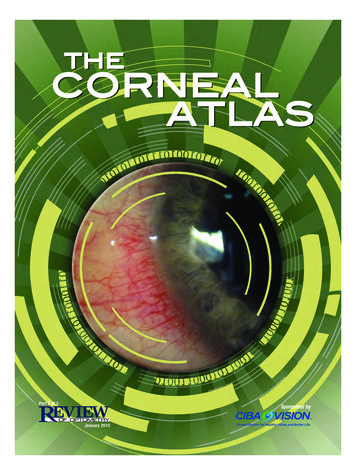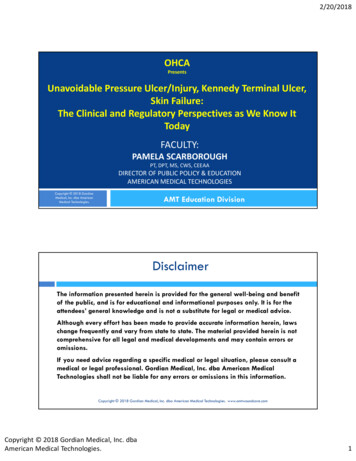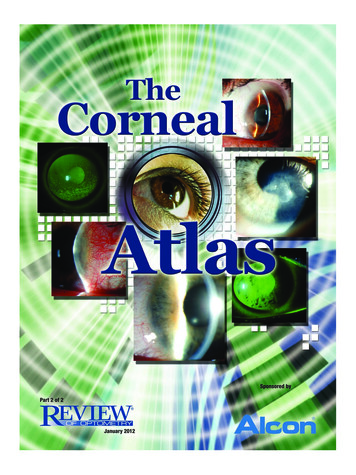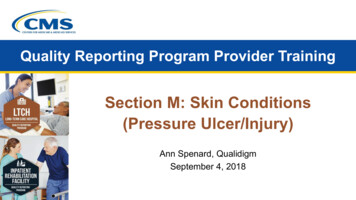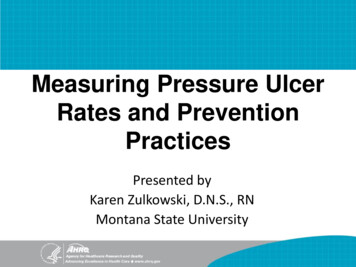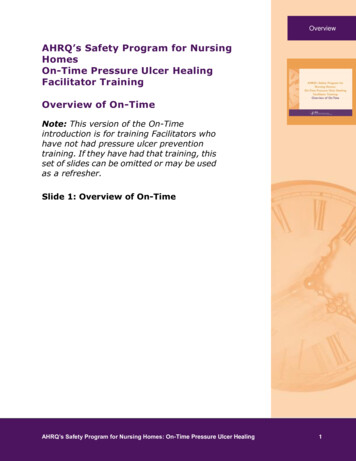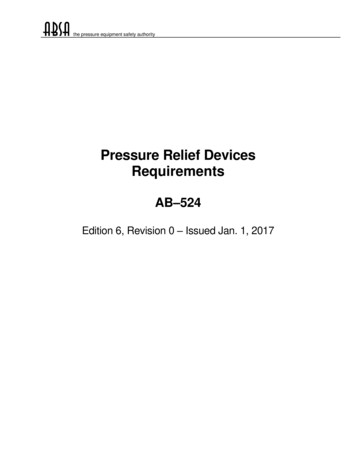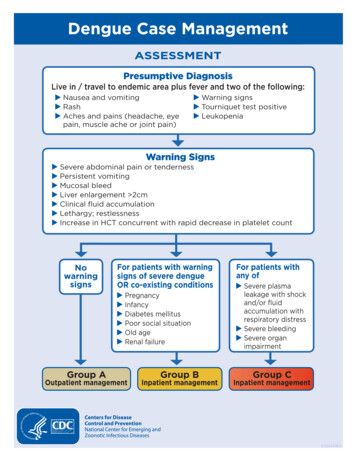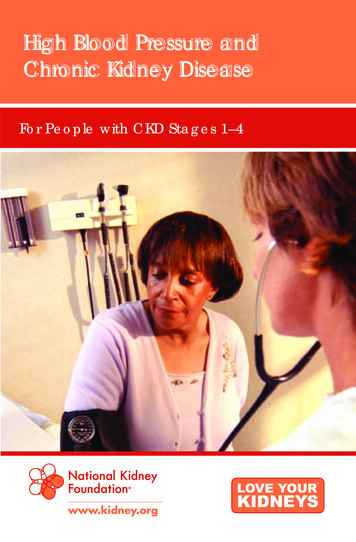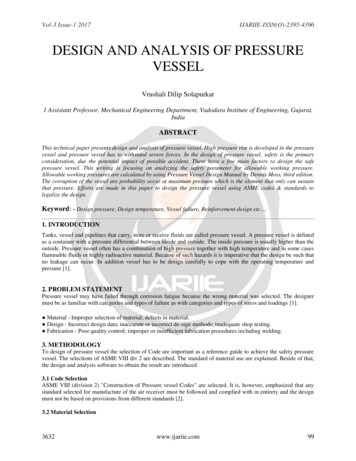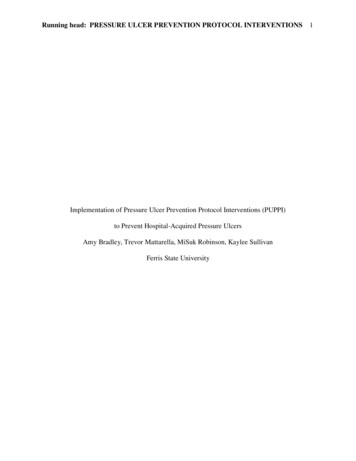
Transcription
Running head: PRESSURE ULCER PREVENTION PROTOCOL INTERVENTIONSImplementation of Pressure Ulcer Prevention Protocol Interventions (PUPPI)to Prevent Hospital-Acquired Pressure UlcersAmy Bradley, Trevor Mattarella, MiSuk Robinson, Kaylee SullivanFerris State University1
PRESSURE ULCER PREVENTION PROTOCOL INTERVENTIONS2AbstractThe purpose of this paper is to review implementation of Pressure Ulcer PreventionProtocol Interventions (PUPPIs) that address preventing or reducing hospital-acquired pressureulcers (PUs) to provide better patient outcomes. Hospital-acquired pressure ulcers are associatedwith increased length of hospitalization, rising healthcare cost, and higher mortality rate.Numerous research studies have contributed to the positive correlation associated withimplementation of PUPPI and decrease in PU incidence. The references are from nursingjournals, textbooks, and nationally accepted PUPPI guidelines from Agency for Health CarePolicy and Research, Agency for Healthcare Research (AHRQ), Institute for Clinical SystemsImprovement (ICSI), and the National Pressure Ulcer Advisory Panel (NPUAP). The goal of thispaper is to present evidence-based research to answer the question “Does the implementation ofPUPPI reduce or prevent hospital-acquired pressure ulcers?”Keywords: evidence-based nursing practice, pressure ulcer (PU), pressure ulcerprevention protocol interventions (PUPPI), research review
PRESSURE ULCER PREVENTION PROTOCOL INTERVENTIONS3Implementation of Pressure Ulcer Prevention Protocol Interventions (PUPPI)To Prevent Hospital-Acquired Pressure UlcersThis paper focuses on implementation of PUPPI to reduce or prevent hospital-acquiredPUs. According to Dibsie (2008) an estimated 2.5 million patients are treated for preventablePUs in the United States at a cost of 11 billion dollars annually. We will examine the question“Does implementation of pressure ulcer prevention protocol interventions help reduce oreliminate hospital-acquired pressure ulcers?” Hospital-acquired PUs may contribute to extendedhospitalization, sepsis, decrease mobility, and poor patient outcomes (Dibsie, 2008). Griffin et al.estimates that 60,000 acute care patients die from PU complications (2007). Nursing researchand evidence-based nursing practice (EBNP) have led to numerous PUPPI to reduce hospitalacquired PUs. Treating PUs can be challenging especially in patients with multiple comorbidities. The hypothesis is that successful implementation of PUPPI interventions prevent orreduce the incidence of hospital-acquired PUs.Description of Article One:Preventing Pressure Ulcers in Hospitals: A Systematic Review of Nurse-FocusedQuality Improvement Interventions (Soban, Hempel, Munjas, Miles, & Rubenstein, 2011)Purpose and problemThe purpose of this article is to review the literature for evidence that PU protocols canbe successfully implemented in hospitals through quality improvement (QI) process (Soban et al.,2011). There are many guidelines and protocols addressing PU prevention from governmentagencies, professional organizations, and healthcare facilities. However there is minimalinformation on how to determine the effectiveness of PUPPI being implemented from a QIprocess (Soban et al., 2011).
PRESSURE ULCER PREVENTION PROTOCOL INTERVENTIONS4Review of literatureThe authors conducted a literature search from six electronic databases for publicationsfrom January 1990 to present (Soban et al., 2011). They screened titles for relevance by hospitalsetting, experimental design study, testing of QI intervention to change the routine care of PUs,and presence of data for nursing process or patient outcome measures (Soban et al., 2011). Theyexcluded research articles that just focused on educational interventions without the otherrelevant criteria. Articles on wound care and site-specific care such as heel care were alsoexcluded from this review. Strategy for the database search was included with keywords andrelevant criteria.Theoretical modelA theoretical model is not clearly identified in this article. Findings indicate that PUPPIall incorporate best practice interventions (Soban et al., 2011). The conceptual frameworkimplied is that a QI process is necessary to determine the effectiveness of PUPPI interventions.Research designMeta-analysis of the research regarding PU incidence and sample size was performedusing the Stata 9.2 program (Stata Statistical Software). Research was categorized by countryand hospital setting (single facility, multi-hospital research, single nursing unit, multiple nursingunits). Majority of the studies utilized uncontrolled before-after design (Soban et al., 2011).Study findingsFrom the literature review 39 studies met the inclusion criteria (Soban et al., 2011). Themost common intervention was the development and implementation of PUPPI. Most of theresearch studies also incorporated staff education as a component of PUPPI. Risk assessmentand performance audits were often included in the protocol. However
PRESSURE ULCER PREVENTION PROTOCOL INTERVENTIONS5implementation of the protocol components varied considerably between the different researchstudies (Soban et al., 2011). Some hospitals employed a one time in-service training for staffwhile other facilities incorporated teaching rounds or included the information in new stafforientation process. Data collection varied from quarterly to annually among the differenthospitals. The most common combination of interventions noted was a protocol change andimplementation of a risk assessment tool. Performance monitoring was included in twenty of thestudies but only nine of those studies also included staff feedback as a QI process. The researchsupported a positive effect on nursing process and patient health outcomes when implementingPUPPI (Soban et al., 2011)Description of Article Two:PUPPI: The Pressure Ulcer Prevention Protocol Interventions(Catania, Huang, James, Madison, Moran, & Ohl, 2007)Purpose and problemThe purpose of this research article is to encourage PUPPI implementation based on theevidence supported by literature review and clinical data obtained by the researchers. PUPPIinclude assessing risk, nutritional status, skin care, documentation, and referrals to WOCN(Catania et al., 2007). The national incidence of PU and high costs associated with hospitalacquired PUs indicate the relevance of this research to nursing practice.Review of literatureThe literature review consists of 24 articles published from 1989-2007(Catania et al., 2007). The authors presented a summary of four research articles that focused oncost of PU treatment and effectiveness of PUPPI (Catania et al., 2007). Majority of the articlesare primary sources from nursing journals but many other sources such as textbooks and
PRESSURE ULCER PREVENTION PROTOCOL INTERVENTIONSnational agency guidelines are included. Agencies including Agency for Health Care Policy andResearch, NPUAP, and Cochrane Database are part of the literature review.Theoretical modelA theoretical model or conceptual framework is not identified in this research study. Atheoretical framework takes the propositional statement and relates it to the research question(Nieswiadomy, 2012). In this article the authors did not present a research question.Research designThe authors did not explain the research design. This was not an experimental designsince all patients admitted to the hospital were included in the study. Each unit was assigned adesignated day of the week to assess patients for PU risk: Braden Scale score, albumin/prealbumin levels, and skin assessment (Catania et al., 2007). Patients identified for risk of PUdevelopment based on assessment score, clinical judgment, diagnosis, treatment regimen, orcomorbidities had a PUPPI ordered. The PUPPI care plan sheet was placed in the patient’sbedside chart and a follow-up assessment completed later in the week by patient care associates(PCAs). The follow-up assessment included documentation of PUPPI performed and basic skinassessment. The PCAs were responsible for notifying a nurse if patients developed any rednessor skin breakdown so that a complete PU risk assessment could be done. Weekly audits byClinical Nurse Specialist tracked number of patients identified at risk for PU, incidence rate,prevalence rate, and compliance with documentation (Catania et al., 2007).Study findingsMore than 700 patients were evaluated with 30% being identified as at risk fordeveloping PU in the first quarter. Weekly audits showed that nurses were 90% and PCAs 80%compliant with documentation. In 2004 the PU prevalence rate was 11.36%. After the6
PRESSURE ULCER PREVENTION PROTOCOL INTERVENTIONS7implementation of PUPPI the prevalence rate decreased to 4% for all PU and 2% for hospitalacquired PU (Catania et al., 2007, pp.46-47).Description of Article Three:Implementing Evidence-Based Practice to Prevent Skin Breakdown (Dibsie, 2008)Purpose and ProblemThe purpose of the article is to provide an analysis regarding implementation of nursingprotocols to reduce PU incidence within hospital settings. Protocols were initiated at a multisiteacademic medical center to assess if EBNP would decrease PU incidence rate. PUs impactpatient health outcome, cost of healthcare treatments, and length of hospitalization. According toDibsie, "Depending on the extent of the tissue involvement, pressure ulcers are noted to require 500 to 40,000 to heal. A more recent view of cost estimates that a full-thickness wound nowrequires 70,000 for associated care to heal." (2008, p. 142). The study showed thatcomprehensive wound care orders sets were in place but were not routinely used. There also wasa lack of documentation regarding wound care treatment and interventions. Dibsie stated,"Although the overall prevalence of hospital-acquired pressure ulcers were lower than reportedCalifornia benchmarks, specialty areas demonstrated prevalence rates significantly higher thanunit-specific benchmarks, signifying a need for action.” (2008, p. 141)Review of LiteratureThe basis for this article was comprised of information collected from popular nursingjournals, nursing textbooks, and medical databases such as Medline, CINAHL, and PubMed.The list of references is made up of 11 sources written between 1989 thru 2007. No obviouscitation errors are noted. The article proposes PUPPI for pressure ulcer prevention, howeverthere are no opposing viewpoints presented.
PRESSURE ULCER PREVENTION PROTOCOL INTERVENTIONS8Theretical ModelA specific theoretical model is not identified in the article. The article is based onnationally accepted interventions from WOCN. The interventions included effective positioningtechniques, repositioning products, and standardized products. According to Dibsie, "Everythinginvolving skin and wound care is now driven, or endorsed, by the WOCN staff and on the basisof national standards.” (2008, p. 144). The nursing staff is encouraged to contact the WOCNnursing staff if they have any questions regarding the nursing protocols for reducing pressureulcers and for new bedside consultations for patients at risk of future skin breakdown.Research DesignThe nursing staff was required to participate in quarterly data collection regardingpressure ulcer prevalence and ongoing implementation of the skin care protocols (Dibsie, 2008).There was no specific sample size mentioned but the information was collected through amultisite academic medical center. Management and CNS support was important to help nursingstaff implement the new protocol and documentation. Another valid member of the researchdesign was the Director of Nursing Performance Improvement.Study FindingsThe findings corresponded to reduction in PUs and skin breakdown after the newprotocols were initiated. Reports showed the peri-operative area improved in identifying andintervening with pressure reduction techniques. Prior to implementing the protocol thepercentage of patients with hospital-acquired stage two or greater PU was nearly 17% in SICUand 7% within the other facility units. Two years after the implementation of these protocols, thepercentages have decreased to 6% in SICU and 4% in other units (Dibsie, 2008, p. 148).
PRESSURE ULCER PREVENTION PROTOCOL INTERVENTIONS9This reduction in hospital-acquired PUs saved the patients from extended hospitalization andreduced overall treatment costs. The study proved effectiveness of the protocol, decreasedtreatment costs, and more importantly improved patient outcome.Article Four:Methodological Issues in Studies of the Effectiveness of Pressure Ulcer PreventionInterventions (Baumgarten, Shardell, & Rich, 2009)Purpose and ProblemThe purpose of this article is to increase understanding of different research methods thathave yielded positive results regarding PU prevention. According to Baumgarten et al. thepurpose is, "To enhance the wound care practitioner's understanding of research methods used toobtain information about the effectiveness of pressure ulcer interventions “ (2009, p. 180). Theextensive impact of PUs in hospitalized patients contributes to increasing healthcare costs topatients and treatment facilitiesReview of LiteratureThe research study was presented in Advances in Skin & Wound Care Journal. The articleswere published from 1979 to 2009 and are from reputable sources such as Journal of HospitalInfections, and Ostomy Wound Management Journal. NPUAP provided nationally acceptedguidelines for developing the PUPPI.Theoretical ModelThe article did not present a specific theoretical or conceptual framework. According toNieswiadomy, "Many nursing studies that are published today contain a clearly identified
PRESSURE ULCER PREVENTION PROTOCOL INTERVENTIONS10theoretical or conceptual framework for the study. Other studies do not." (2012, p. 93). Thearticle is reputable without a theoretical model since the references are credible and directlycorrelated with the PU interventions.Research DesignThe main research design used for this article analysis was randomized control trials(RCT). According to Baumgarten, "In an RCT trial, patients who agreed to take part in the studyare randomized, that is, they are assigned at random, to the intervention group or to thecomparison group. Both groups are followed for a specific period of time to determine if theydevelop a new pressure ulcer.” (2009, p. 181). The RCT design is appropriate since the results ofstudies with randomization provide the strongest evidence that there is a positive correlationbetween intervention and outcome (Baumgarten et. al., 2009). The randomized study has beenutilized for many years, but they also have some disadvantages. At many facilities it is simplynot feasible to fund a randomized study since they can be expensive. Ethics is another importantfactor of this research design as beneficial treatment should not be withheld from the controlgroup to prove a correlation within a study.Study FindingsThe focus of the study was to reduce PU incidence through the implementation of a skincare protocol. The existing skin care protocol was modified to include a body wash and perianalskin protectant to be applied after each episode of incontinence (Baumgarten, 2009). Accordingto Baumgarten et al., "A significant decline in pressure ulcers was observed from 32.7% beforethe intervention to 8.9% after the intervention." (2009, p. 184). It is difficult to perform a blindstudy because the PU prevention device or protocol cannot be concealed and the study group isaware of the treatment. According to Baumgarten et al., "Evidence-based practice requires that
PRESSURE ULCER PREVENTION PROTOCOL INTERVENTIONS11decisions about health care be based on, among other things, findings from high quality research.”( 2009, p.187). EBNP interventions incorporating a skin care protocol demonstrated to beeffective in reducing the incidence and development of PUs in hospitalized patients.Critical Appraisal Of The Evidence of Article One:Preventing Pressure Ulcers in Hospitals: A Systematic Review of Nurse-FocusedQuality Improvement Interventions (Soban et al., 2011)Purpose and problemThe purpose is not clearly identified in the research or in the title of the article. Thepurpose of this research was to look at the current literature on various PUPPI being utilized. Theprimary focus centered on evaluation of reporting of nursing process change, patient outcomes,and the correlation of interventions and outcomes of PU prevention in the hospital setting (Sobanet al., 2011). According to Nieswiadomy (2012) the authors should have used a correlationalstatement identifying the variables to clearly state the research purpose. This would also beconsidered a bivariate study as the authors are looking at the correlation between PUPPI and QIprocess on PU prevention outcomes. The authors did state the significance of this research tonursing practice and tools for data collection was included in case anyone wanted to replicate thestudy. This research met the guidelines for a quantitative study and empirical data was obtainedsuch as PU prevalence rate, frequency of data collection, types of interventions beingimplemented, and patient outcome.Review of literatureThe literature review is comprehensive, relevant to the research study, and criticallyappraised. The authors established detailed inclusion criteria in reviewing the literature review.Majority of the articles are primary sources from nursing journals. All the articles were published
PRESSURE ULCER PREVENTION PROTOCOL INTERVENTIONS12after 1990 (Soban et al., 2011). The reference page does not follow current APA (6th ed.) formatof alphabetical listing, complete spelling of journal names, and author listing (APA, 2010). Allthe citations used in the article can be found in the reference page. The opposing theory is notpresented.Theoretical modelA theoretical model is not identified in this research study. Soban et al. indicated that QIprocess is imperative to prove the efficacy of PUPPI implementation (2011). A middle-rangetheory would be appropriate for this study as the focus is narrowed to PU prevention inhospitalized patients (Nieswiadomy, 2012).Research designA random effects meta-analysis for systematic review of literature was the foundation ofthis research study. The authors searched PubMed with very specific screening guidelines forarticles published after 1990. Electronic database search resulted in 1,646 documents in which314 research studies met the inclusion criteria for further review. The second review resulted in39 research studies that met the criteria using the two tools developed by the authors (Soban etal., 2011).Sampling methods. Two independent reviewers screened the literature review of 314studies published after 1990. Total of 39 studies met the inclusion criteria. The inclusion criteriaincluded the following elements: Team assembled Guidelines/protocols implemented Risk assessment tool Plan-Do-Study-Act (PDSA) process
PRESSURE ULCER PREVENTION PROTOCOL INTERVENTIONS Staff education Link/resource nurse Performance monitoring Feedback13(Soban et al., 2011).Data collection methods. The authors performed random effects meta-analysis of studiesthat reported incidence or prevalence of PUs (Soban et al., 2011). Meta-analysis is a statisticalmethod of analyzing data from different studies in determining if a pattern or correlation exists(Triola & Triola, 2006). In this article the authors combined the data from several differentresearch studies that implemented different PUPPI to formulate a consistent assumption of theeffects on PU incidence rate.Instruments. The authors developed two tools to evaluate the research articles. Thefirst tool defined the PUPPI component and frequencies of the component beingimplemented. The various components are: protocol developed/implemented: implementing protocol-based care staff education: written, didactic, or other means to increase staff understanding risk assessment tool: implementation of assessment tools such as the Braden Scale performance monitoring: collecting data at least three times during the study team assembled: formation of new team to plan implementation beds/support surfaces: process of using new equipment/mattress guideline implemented: interventions based on published guidelines feedback: process to increase awareness and monitor progress link/resource nurse: identification of nurse to provide information to staff
PRESSURE ULCER PREVENTION PROTOCOL INTERVENTIONS14The second tool evaluated the quality of the studies. Eight elements were listed with definitions.Each element was assigned a quality score of 0 (low), 1 (medium), and 2 (high) (Soban et al.,2011).Data analysis. The most common PUPPI components reported are the implementationof a protocol-based care (74%), staff education (72%), and risk assessment tools (54%). Only51% of the studies incorporated performance monitoring. The use of feedback with performancemonitoring was only present in 23% of the research. The reporting of process and patientoutcome data occurred with high quality in only 15% of the research. The combined dataanalysis of PU incidence outcome from all the research studies was reported in a random effectsmodel. The PU outcome incidence reporting indicates that overall PU incidence decreasedslightly after implementation of any PUPPI protocols with a p .0001 and a 95% confidenceinterval (Soban et al., 2011, pp. 247-248).Study findingsAlmost all the studies concluded that any PUPPI had a positive effect on nursing processand patient outcome (Soban et al., 2011). The authors noted “considerable heterogeneity acrossstudies, so the pooled effect should be viewed with caution.” (Soban et al., 2011, p. 249). This isone of the known weaknesses of this type of research and that is why the random effects metaanalysis is an appropriate study design for this research. Placing greater emphasis on QI processwhen implementing PUPPI will help understand why some protocols are more successful thanother interventions
PRESSURE ULCER PREVENTION PROTOCOL INTERVENTIONS15Critical Appraisal of Article Two:PUPPI: The Pressure Ulcer Prevention Interventions (Catania et al., 2007)Purpose and problemThe problem identified is the incidence of PUs in hospitalized patients, associated cost ofPU treatments, and morbidity related to PU complications (Catania et al., 2007). The purpose ofthe article is to provide evidence-based PUPPI implementation process based on literature reviewand data from the study. The authors clearly identified the significance to nursing practice byreferencing data of PU related mortality rates. The feasibility of the study is evident as the toolsand collection process of data are clearly outlined. The study was ethical as all patients were partof the study. This was a quantitative study and empirical data collected included the BradenScale score, type of PUPPI intervention ordered, frequency of PUPPI interventions, laboratoryvalues, and nutritional assessment (Catania et al., 2007). The population was all hospitalizedpatients. According to Nieswiadomy (2012) a purpose statement should be written ininterrogative form, include specific population, identify variables, and be empiricallytestable. The authors did not identify this research as a multivariate study or provide acorrelational statement of the research problem.Review of literatureThe literature review is comprehensive and concise listing only 24 articles publishedfrom 1987-2007. The older articles indicate the historical significance of this problem. Thearticles are from primary sources as they are mostly from nursing journals with a few frommedical journals and government agencies. All citations used in the article appear in thereference page. Nieswiadomy recommends that supporting and opposing viewpoints should be
PRESSURE ULCER PREVENTION PROTOCOL INTERVENTIONS16included in the literature review (2012). The research study did not present any opposingviewpoints that may affect successful implementation of PUPPI.Theoretical modelA theoretical model or conceptual framework is not presented in this study. Aquantitative study should be based on theoretical or conceptual framework (Nieswiadomy,2012). A propositional statement based on a specific theory delineates the hypotheses andrelates the research question to the framework of the study.Research designThe research design is not clearly described in this study. A QI team was formed thatdeveloped a PUPPI based on the literature review of guidelines from WOCN Society, AHRQ,and NPUAP (Catania et al., 2007). An assessment tool was developed and data collected weekly.Staff education was a major component that included training in the Braden Scale, standardizedskin assessment, computer order entry, documentation, critical thinking exercises, and mentoring(Catania et al., 2007).Sampling methods. All patients admitted to the hospital participated in the study.Hospitalized patients assessed to be at risk for PU were identified and monitored for datacollection. Nieswiadomy recommends that researchers address sampling methods, identify thedemographics of the sample, dropout rate from the study, and possible sampling bias(2012). This study did not include any other information than the number of the sample size andthat they were all hospitalized patients at risk for PUs.Data collection methods. Data was collected twice a week by chart audits. Theresearchers looked at the number of patients identified as at risk, percentage of documentedinterventions, and compliance with staff completing the audit forms (Catania et al., 2012)
PRESSURE ULCER PREVENTION PROTOCOL INTERVENTIONS17Instruments. The QI team developed a PUPPI based on nationally accepted guidelinesfrom AHRQ, NPUAP, and WOCN Society. The Braden Scale assessment tool was incorporatedin the PUPPI. However, tools for data collection was not included in the article. An audit formis mentioned but not explained or discussed. According to Nieswiadomy data-collectioninstruments should be clearly identified and described since this will affect the reliability of thedata being collected (2012). The characteristics of the data-collection tools may affect thevalidity of the research and cause barriers in replication of the study.Data analysis. Data reported to the National Database of Nursing Quality Indicators(NDNQI) in 2003 prior to PUPPI implementation demonstrated 19.47% PU incidence rate and12.39% hospital-acquired PU prevalence rate that was almost 50% higher than the NDNQIbenchmark for PU (Catania et al., 2007). In the first quarter of the study nursing compliancewith completing the audits was 90% and 80% among the PCA. After implementation of PUPPIthe PU incidence rate decreased to 4% and 2% for PU prevalence that is well below the NDNQIbenchmark (Catania et al., 2007). The authors did not provide adequate descriptive statistics inthis research. There is no information on the sample characteristics other than all hospitalizedpatients. There was no breakdown of central tendency, variability, or relationships of the datacollected.Study findingsThe authors noted that continuous monitoring and evaluation of PUPPI provided data tosustain practice changes based on evidence-based research. Staff education, communication, andadministrative support were critical for successful implementation of PUPPI. However, theauthors did not provide necessary information on research design to replicate this study.
PRESSURE ULCER PREVENTION PROTOCOL INTERVENTIONS18Instrumentation for data collection was not comprehensive, theoretical or conceptual frameworkwas not included, and a focused research problem or statement was missing.Critical Appraisal of Article Three:Implementing Evidence-Based Practice to Prevent Skin Breakdown (Dibsie, 2008)Purpose and problemThe article by Laura Dibsie focused on implementing EBNP to prevent skin breakdownand reduce PU incidence. The research question presented is “Does the implementation ofevidence-based nursing practice prevent skin breakdown?” The author does not list a particularhypothesis but the study focus about PU prevention is a clearly identified.Review of literatureThis article is based on information from a collection of nursing journals, textbooks, anddatabases concerning PUPPI. The reference list contains eleven sources between the years of1989 thru 2007. No obvious errors are noted in the reference citations. The authors do notpresent any opposing viewpoints.Theoretical modelThe article would have been more effective with a theoretical model identified. Nationalstandards endorsed by WOCN is the foundation for all skin and wound care (Dibsie, 2008). Thisinformation will contribute to new national standards for better patient outcomes.Research designThere is no specific research design mentioned in the study, however it focused onmethods to ensure compliance with standardized products and protocols. The study was based oninformation presented by WOCN increasing the credibility of the information.
PRESSURE ULCER PREVENTION PROTOCOL INTERVENTIONS19Sampling methods. The sampling methods are briefly outlined, however they are notclearly identified in the article. The study focused on patients within a 54 bed critical care unit.According to Nieswiadomy, "Generally speaking, quantitative studies seek to obtain samplesizes large enough to talk about the population of interest." (2008, p. 155).Data collection methods. The source of data collection in the analysis was found inperiodic PU prevalence data collection. According to Dibsie, "Participation in quarterlyprevalence pressure ulcer data collection was the method chosen to monitor the impact of theimplementation and ongoing utilization of the skin protocol" (2008, p.143).Instruments. The new skin care protocol was implemented through nursing staffeducation regarding standardized product lines. These pro
Ferris State University . PRESSURE ULCER PREVENTION PROTOCOL . using the Stata 9.2 program (Stata Statistical Software). Research was categorized by country and hospital setting (single facility, multi-hospital research, single nursing unit, multiple nursing . of national standards." (2008, p. 144). The nursing staff is encouraged to .
